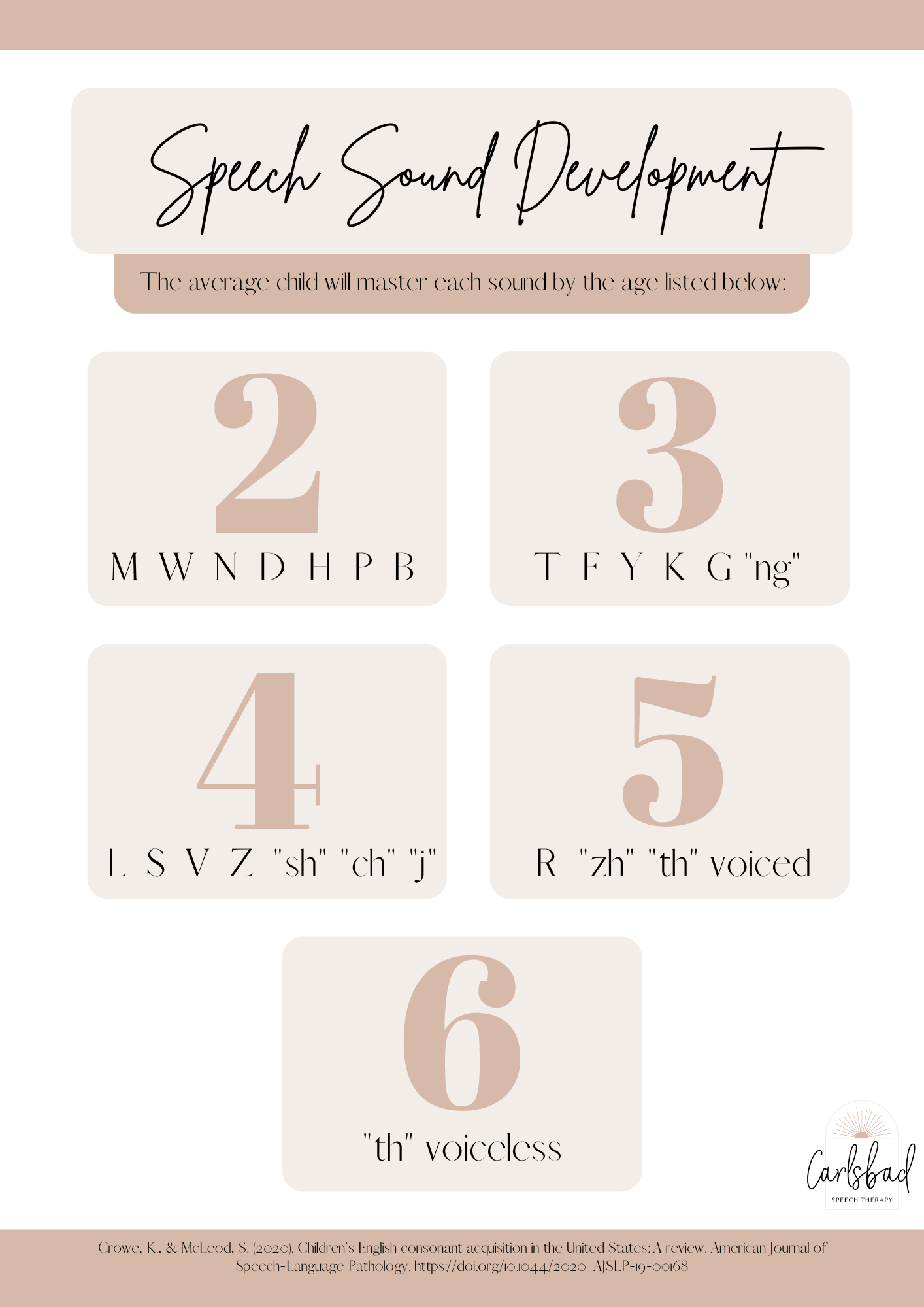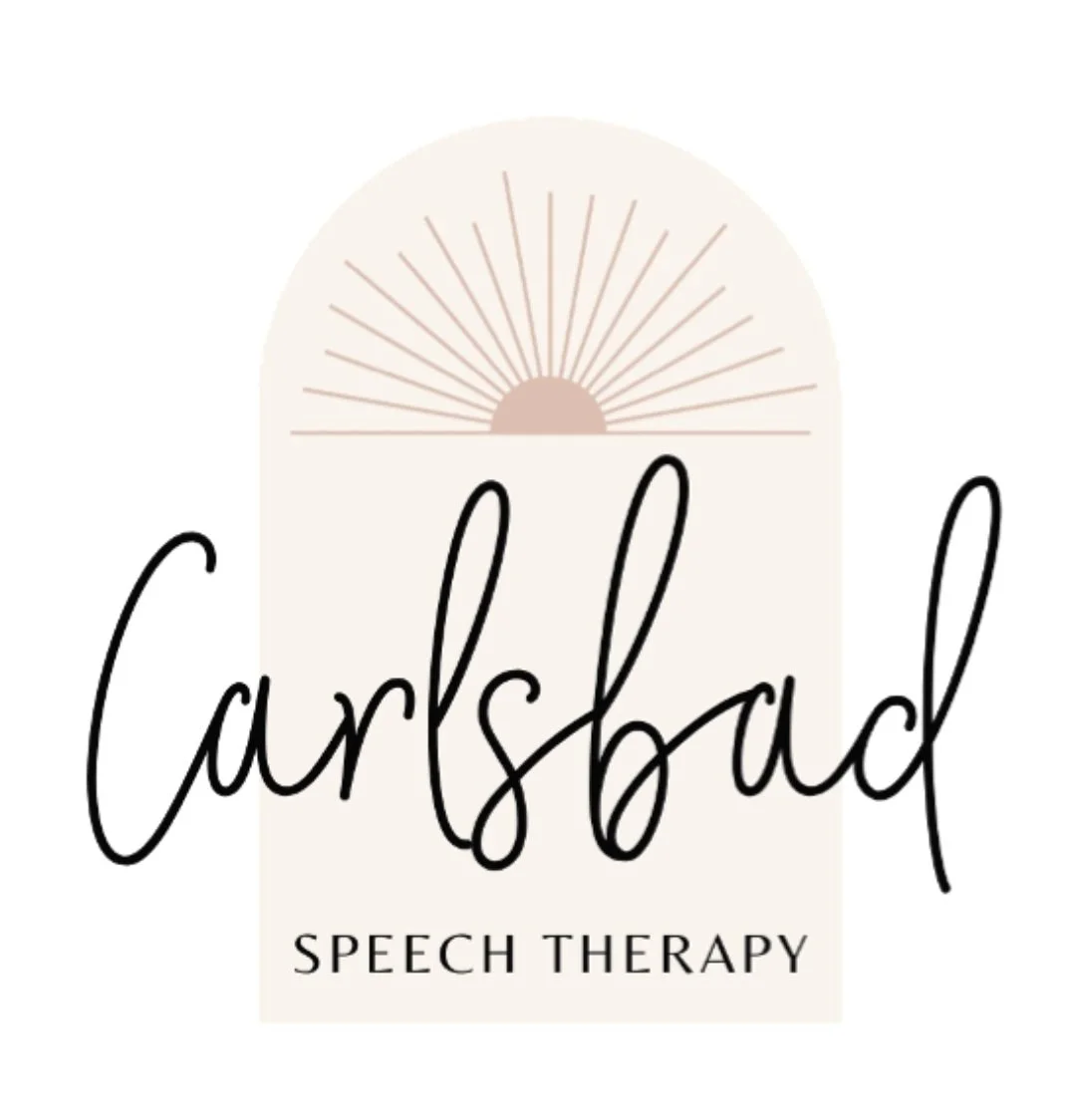What is speech therapy?
What is Speech Therapy?
Speech therapy is an intervention service that focuses on improving a persons communication and/or swallowing abilities. Areas addressed by speech therapy are vast and include: speech sound production, language use and comprehension, fluency, voice quality, social skills, cognitive-linguistic abilities, auditory verbal therapy, and swallowing disorders. Speech therapists, or speech language pathologists (SLPs), are the professionals who provide these services.
Who needs speech therapy?
Both children and adults benefit from speech therapy services. A child may need speech therapy services if they are not successfully meeting developmental milestones naturally. Maybe they are having trouble producing their “L” sound, or they are a “late talker”. Speech therapy for children is focused on developing and acquiring skills. Speech therapy for adults is rehabilitation based and may be necessary if a person has lost communication, cognitive skills and/or swallowing abilities. Speech therapy is commonly recommended for adults after experiencing a stroke, traumatic brain injury or when diagnosed with a neurodegenerative condition.
In this blog we will be covering frequently asked questions regarding speech therapy for children.
What Do Speech Language Pathologists Do?
Speech language pathologists provide a wide range of services, including speech & language screenings, comprehensive evaluations and therapy services. Some SLPs also design and run parent education and training courses, participate in community outreach programs and facilitate language enrichment groups. SLPs can work in a wide variety of settings, from hospitals to schools to private practices. No matter the setting, all speech language pathologists have gone through a rigorous 2 year masters degree, completed 400+ clinical hours of training and received a passing score on the national board exam.
That being said, it is important when you are looking to find an SLP that you ask what their specialties are. Similar to a doctor, no speech therapist will - or should- be an expert in ALL areas. Many will specialize and focus their expertise. For example a child with autism who communicates with echolalia should be treated by an SLP who understands Natural Language Acquisition and Gestalt Language Processing. A child who is deaf should be treated by an SLP who is confident and experienced in Auditory Verbal Therapy. An SLP should always provide you with honesty and refer you to another professional if they feel they are not able to provide the best services for your child.
Speech Language Pathologists treat a wide variety of disorders.
Are there different speech therapy settings?
Yes! Children can be seen for speech therapy in several different settings. Below are some examples of settings a child may see a speech language pathologist and what those services may look like:
Early Intervention
Early intervention (EI) encompasses speech therapy services for children 0-3 years of age. In the sate of California (we are located in San Diego) a child presenting with speech or language delays under three years of age can receive free speech therapy services through the programs like the Regional Center. Speech therapy sessions focused on early communication skills will take place in on a weekly basis and often times a speech language pathologist will come to your home to provide these services. Parent participation and training is a primary focus during early intervention, and parents are encouraged to sit in on sessions in order to learn and practice speech and language facilitation techniques and strategies.
School Based Speech Therapy
Once a child turns 3, they are eligible to receive a free speech and language evaluation and speech therapy services through their local school district. School based speech therapy is typically in a group setting of 2-5 students and the child will attend during school hours (No speech therapy on weekends, holidays or summer vacation). SLPs in the school setting work closely with teachers and focus on how speech/language skills impact education and classroom learning. Speech goals are tied to the curriculum and IEP meetings are scheduled yearly to review goals. Every three years the child is re-assessed to determine continued eligibility. Schools have strict qualifications for services, meaning mild delays and disorders may not be addressed - especially if the child is performing well academically.
Private Practice
At any age, a parent can seek private speech therapy services for their child. There is some flexibility for private practice in terms of location. A child can be seen at a clinic, at their private preschool (if the preschool gives permission) or at the child’s home. Private speech therapy is usually 1-on-1 with the speech therapist, which allows for individualized and highly effective treatment. Goals are created to address the functional skills and needs of the child and their family and are not restricted to academics. Private therapy is typically provided consistently throughout the year with no long breaks and chances for regression of skills. Some private practices take insurance and others require parents to pay out of pocket. Depending on the clinic you go to, use of an HSA or FSA account may be acceptable. You may also be eligible for financial reimbursement if you submit a superbill to insurance.
Does my child need speech therapy?
This is a challenging question for parents and guardians to navigate on their own. To help, below are some common scenarios that would justify the need for a consultation with a speech language pathologist.
ARTICULATION: If a child is distorting sounds or simply not able to produce age-appropriate speech sounds. For example, a four year old who cannot produce their “f” sound would benefit from speech therapy as this sound is mastered by 90% of children at age 3. Check out our speech sound development chart to see if your child is on track with their use of speech sounds.
PHONOLOGY: If a child is substituting or omitting certain sounds (e.g. “tat” for “cat”) past a certain age. Phonological processes are speech patterns or “short cuts” that children use because they are easier to produce. This is completely normal and expected up to a certain age. Some children; however, get stuck in these patterns and need help learning the inherent rules of speech sound production. Use this guide to help determine if your child is exhibiting phonological patterns.
EXPRESSIVE LANGUAGE: If a child is struggling with using language to express their wants, needs, thoughts and idea. Many times children with expressive language delays are labeled as “late talkers”. While there is a considerable amount of variability for language development, typically children are able to produce a few early words around 12 months and putting 2 words together by 24 months. For older children, expressive language difficulties may manifest as limited vocabulary, simplified sentences, difficulty with plurals/verb tenses and overall sentence expression.
RECEPTIVE LANGUAGE: If a child is struggling with comprehension of language. Early receptive language skills include responding to name, demonstrating understanding of common words/phrases, and following simple verbal directions. Later developing receptive skills include following multistep directions, and answering wh- questions (who, what, where, when, why). If you have concerns about your child’s language comprehension, many SLPs are able to provide free screenings to determine if the concerns require intervention.
PRAGMATICS: If a child struggles with using communication and language appropriately across social contexts. These skills include: using language (i.e. to greet, inform, demand and request) adapting language (i.e. changing language for different listeners, adjusting voice volume for different situations, adapting to listenter’s knowledge) and following the “unspoken” rules of language (i.e. taking turns in conversation, looking at the speaker, using appropriate physical distance, using facial expressions/gestures). Commonly, children with Autism Spectrum Disorder (ASD) struggle with the inherent social rules of communication.
VOICE: If a child has an abnormal voice quality (e.g. nasal, breathy, raspy, or hoarse speech) it is recommended that you first address concerns with your pediatrician and request a referral to a pediatric ENT. Frequently voice concerns have a medical etiology, but speech therapy is often recommended in conjunction to improve vocal quality and train parent and child in vocal strategies.
FLUENCY: If a child exhibits atypical repetitions or pauses when speaking. Stuttering is a common fluency disorder that parents notice as their child begins putting words together to form sentences. Children with fluency disorders can exhibit sound repetitions (t-t-t-talk), word repetitions (he, he, he said), phrase repetitions (Can I, can I, can I go?), prolongations (sssssnake), and blocks (It was ——- cool). Excess tension in the facial muscles and body can also be present along with extraneous movements (e.g. eye blinks, squinting). Reach out to a speech language pathologists if you have concerns.
Speech Sound Development Chart
Does your child have all their expected sounds?
When should I consult a speech Pathologist?
Consult with a speech language pathologist as soon as you notice your child is not meeting their milestones. Often times, it is difficult for a parent to determine if their child’s speech and language is age appropriate. Are they delayed or are they just developing a little slower than their best friend or the kid down the street? There is so much variation in speech and language development and this is a huge reason many parents don’t seek speech therapy services right away. In addition, parents are often told during check ups to “wait and see” how they are doing closer to their third birthday. The problem is this causes the family miss out on state funded early intervention services and the child will likely fall further behind. Research shows the earlier a child starts speech therapy, the greater likelihood the intervention provided will be successful.
How successful is speech therapy?
Sometimes children progress rapidly with speech therapy and sometimes progress is slower - and thats OK! The overall success of speech therapy depends on a variety of factors. These factors include:
Age of the Individual – Research has shown that the earlier the individual begins speech therapy, the more likely that speech therapy will be effective. The “wait and see” mentality is not recommended as it can make therapy down the road more challenging.
Type of Communication Disorder – Most communication delays or disorders can be eliminated or significantly reduced given participation in skills speech therapy intervention. There are certain conditions, such as stuttering, for which there is no known cure. Therapy for this population focuses on managing stuttering and improving communicative success and confidence.
The Severity of the Communication Disorder – Speech therapy for mild delays or one area of need are likely to make quicker and more consistent progress with therapy than those with complex and severe delays.
Frequency and Consistency of Appointments – The success of speech therapy also depends on how frequently the appointments occur, and how consistent the individual is with their attendance and participation in each appointment. Just like starting a new exercise routine, achieving goals takes time and dedication. A speech pathologist provides instruction on proper techniques & activities; but it is just as much the individual’s responsibility to practice those techniques in a consistent manner.
Home practice – While speech therapy sessions are vitally important, spending time practicing specific techniques outside of the session is also an essential part of speech therapy. Being able to generalize skills learned to everyday situations is the end goal of therapy.
Underlying Medical Conditions – If the communication challenges are related to a medical condition, the success of speech therapy will depend on the severity of the condition and medical factors impacting participation and learning.
Support from Caregivers – The success of speech therapy also depends on the ability of family members, teachers, and other caregivers to support the individual. As mentioned above, spending time on speech therapy exercises outside of sessions is a vital part of a speech therapy program. Often this requires the help and support of others to encourage and facilitate.
What are some speech therapy techniques?
The short answer - there are too many to name! Speech therapy techniques are individual to each and every child. A speech therapist will assess your child and, work with you to identify goals for therapy and trial specific techniques to find out what is most effective.
As an example, let’s go over some common techniques for encouraging first words in young children. Here are some of my favorite, simple strategies which can be used with any child, regardless of their current language abilities.
Naming: Provide your child with labels for the items they are looking at and playing with (e.g., Airplane, blocks) and the actions taking place during play (e.g., push, squeeze). The more a child hears a word, the more likely they are to practice saying them.
Commenting: Use short, simple phrases and sentences to talk about what you and your child are doing (e.g. “big jump”, “squeeze the glue”). Using simple language during play provides additional vocabulary to your child, and encourages them to try to use these words as well. TIP: modeling without any requirement or pressure to repeat is key.
Providing Choices: Offer your child a choice between two items (visible and tangible items work best). Name both items, then let your child choose by pointing, words, sounds or gestures. Then repeat the name of the object they have chosen. Offering choices encourages your child to interact and use words rather than responding yes/no or not responding at all.
Pausing: After saying something to your child or when holding up a toy, pause and give your child an expectant look. The pause gives them a chance to process and formulate a response (wait at least 5 seconds!). The expectant look encourages them to participate in the exchange. If they do not say anything, you model the words that match the activity. Example: When holding a jug of juice, say “Open the…. (pause)” and wait for them to say “juice”. If they don’t say anything or say something incorrect, simply model the correct word/s.
Copy & Add: Also referred to as expansion…If your child says a single word, try repeating it back and adding a word (e.g. if your child sees a dog walking outside and says “dog”, you can respond with “big dog” or “dog outside”). If your child uses a phrase, you can use this strategy to fill in the missing words (e.g. child: “mommy go”, adult: “Mommy is going out”). By expanding we are providing a clear model that is easier for the child to learn because it builds on a word the child is already using!
Communicative temptations: Introduce toys that are hard to operate, or put toys inside hard to open boxes. If your child communicates with gestures, movements or sounds, model the word for them (e.g. “open”, “help”). By creating opportunities for your child to communicate, you are also developing their communication skills.
This is just a brief list on a specific topic. A huge part of therapy is teaching children and their families techniques and strategies to facilitate progress with speech and language development.
What are the long term benefits?
We discussed above how speech therapy can help improve speech production, comprehension and use of language, fluency, voice, cognition and even swallowing. Speech therapy also helps children build overall confidence in their communication! Speech, phonology and language are directly correlated to reading and writing skills and help support academic success. The social impact is important to discuss as well. It is not uncommon for children who are struggling with producing speech sounds and/or language skills to shut down, refuse to talk/repeat or experience outbursts of frustration. A solid foundation in communication can support building friendships and improve self-image which are vital skills needed during childhood, adolescence and into adulthood.
How to find a great speech therapist?
Contacting the SLP at your child’s school is a great start. School based services are free and (as a previous school SLP) I can vouch for their creativity and passion for helping children. A downfall of speech therapy in the schools is the lack of individual treatment - majority of students are seen in group settings - and mild delays typically will not qualify for services.
If you are looking for a private practice, a google search can be overwhelming. Take time to consider a multitude of factors including proximity, availability, years of experience, areas of expertise and reviews from past clients. The field of speech therapy is VAST and many speech therapists choose to specialize in a particular area. For example: If you suspect your child has a stutter, make sure to ask the speech therapist if this is an area they specialize in and are confident working with. Some speech therapists provide in-home services, while others are in a clinic based setting. Ultimately, it is important to find someone who “clicks” with your child. If your child is not excited or motivated to participate in speech therapy or work with their clinician, you may want to consider finding a better fit.
At Carlsbad Speech Therapy we provide in-home speech therapy services for children birth-early adolescence. We specialize in early language development, speech sound disorders and phonological delays, Autism and Gestalt Language Processing, and Deaf and HOH population. If you are interested in learning more information feel free to check out our website!




